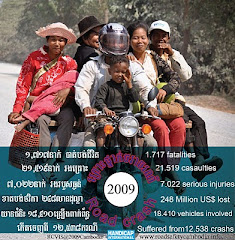The rate of helmet wearing among motorcycle drivers in the Cambodian capital of Phnom Penh has more than tripled between June 2008 and August 2009, according to a recent report released by Handicap International Belgium (HIB).
The latest figures from Cambodia's Road Crash and Victim Information System (RCVIS), meanwhile, show that the helmet wearing increase has led to a nationwide 3-percent drop in motorcycle crash fatalities due to head injuries.
The increase is significant as road crashes are a major cause of death, injury and disability in Cambodia, especially among young road users. Over the last five years, the number of crashes has increased by 150 percent and the number of fatalities has almost doubled, according to RCVIS.
Motorcycle riders are particularly vulnerable. More than three-quarters of the total number of casualties and 68 percent of fatalities involved motorcycles. A third of these casualties are between the ages of 15-24. The lack of helmet wearing among motorcyclists is a major contributing factor to head injuries. Out of the 19,879 motorcycle casualties in 2008, 93 percent were not wearing helmets. As a result, head injuries accounted for 44 percent of total injuries.
The primary reason for the increase in helmet wearing rates is the multi-stakeholder helmet awareness campaign linked with nationwide enforcement of the helmet wearing law for the first time, beginning on January 1st 2009, by the Cambodian Traffic Police.
The interactive elements of the helmet-wearing promotion campaign sponsored by the Global Road Safety Partnership and implemented by HIB and the National Road Safety Committee included:
1. Handicap International Belgium, Global Road Safety Partnership (GRSP) in collaboration with the National Road Safety Committee, Ministry of Interior, and other partners conducted a road safety awareness campaign targeting the public on the importance of helmet wearing during November to December 2008. This campaign also informed the public of the upcoming enforcement of the helmet laws
2. The Ministry of Interior set the date for helmet wearing enforcement on 1st January 2009. To encourage the police as role models, a distribution of 2000 helmets to traffic police officers in all provinces was conducted in November 2008;
3. Prior to helmet enforcement, training on professional helmet enforcement techniques for the Traffic Police was conducted by international police experts in December 2008;
4. A distribution of subsidized helmets was conducted to selected high schools in Phnom Penh prior to the helmet enforcement date by the National Road Safety Committee in expectation of increasing helmet wearing amongst young students;
Due to these education and enforcement efforts above, independent surveys conducted beforeand after the January 1st enforcement date showed that the helmet wearing rates among motorcycle drivers doubled from 24% in June 2008 to 56% (February 2009).
Furthermore, the same survey also demonstrated that attitudes towards helmet wearing also improved with a greater majority stating their belief that helmets are an important safety feature when driving.
The project also had unexpected but welcomed multiplier effects in two ways:
1. The success of the activities above convinced other road safety actors both from civil society and the government to prioritizing helmet wearing activities in their long-term road safety strategies;
2. With enforcement, this project gave the Ministry of Interior and the National Traffic Police the motivation and confidence to ramp up enforcement of the helmet law, launched in August 2009. The law was strictly enforced, resulting in the current helmet rate of 85%.
Challenges remain however. There is no helmet law for motorcycle passengers so the rate remains low. Helmet wearing rates in the rural areas are noticeably lower than in the urban areas. However, as this project has demonstrated, positive impact on behavior and attitude change can be achieved by linking education and enforcement.
more resource: www.roadsafetycambodia.info


No comments:
Post a Comment